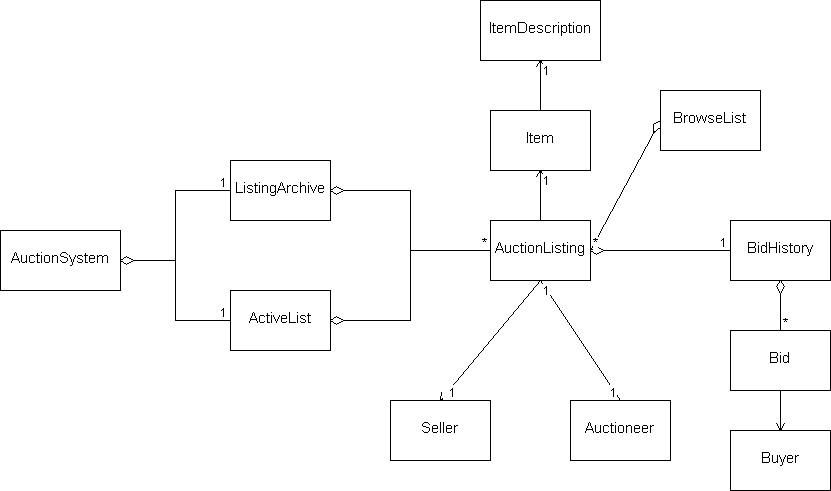class would look like:
public class ActiveList {
/** list of AuctionListing objects
*/
private ArrayList<AuctionListing> auctListings;
// add methods and attributes from the class diagram
};
and initial code the AuctionListing class is:
public class AuctionListing {
// object references from aggregations and associations:
private Item item;
private BidHistory bidHist;
private Seller seller;
private Auctioneer auctioneer;
// object attributes:
private Date deadline; // auction deadline
private double startPrice; // the auction starting price
};
From the sequence diagrams we determine the main course of action for methods, as
described in the use cases.
Consider the "List Item" sequence diagram:

(violet)
The sequence diagram shows the time order for messages sent between objects while
performing a use case scenario.
In UML, the fact that "an object A sends a message m()
to another object B", maps in an object-oriented programming language (e.g. Java)
to "object B implements method m() and object A invokes method m() on object B".
The UML notation for a message (arrow) does not show that the target object
may return a value. It is assumed that it terminates processing the message at the
end of the activation block.
The basic rules for mapping a sequence diagram to code are:
- for each object, an "incoming message" maps to a method that must be implemented
by the object receiving the message.
- for a complete application implementation, all objects in all sequence diagrams must be
considered according to these rules.
- the message name, return value and parameter list (signature) map to the method signature
in the code implementation.
- the code implementation still must be fully defined even if the sequence diagram is
high-level, or a message signature does not specify return value or parameters.
- the method implementation consists in part of the messages the object sends during
the current message activation box. If object A sends a message m(...) to another
object B, then the mapping to A's code is a call
B.m(...).
- the message order from the sequence diagram must be preserved in the method code.
- sequence diagrams for alternate scenarios (e.g. success vs. failure scenario)
may include the same message sent to a particular object, but showing a different sequence.
The code from alternate sequences must be merged during the implementation using
if-else branches. (see the
listItem() method below)
If the code gets too complicated, try breaking it into multiple (helper) methods.
- if object A sends a message to object B, then object A must have a reference to
the B object (A calls B.someMethod()). The reference to B object may be an instance
variable of the A object, or a local/temporary variable obtained indirectly
(e.g. through accessors applied to third-party objects).
- consider adding such reference instance variables as appropriate.
- methods implementing messages between objects should have "package" or
"public" visibility. Helper methods are "private".
NOTE: always keep applying the concepts and methodologies from Chapters 2 & 3.
Think about encapsulation, side effects, the Law of Demeter.
In this above figure, the Seller object sends a listItem() message
to the :AuctionSystem object. Thus, class
AuctionSystem must implement method listItem(). The
AuctionSystem.listItem() method simply invokes the listItem()
method on the ActiveList object.
The ActiveList.listItem() method is a bit more complex:
public class ActiveList {
.......
public void listItem(Item it, Date deadline, double price) {
// create new AuctionListing (call constructor):
AuctionListing al = new AuctionListing(it, deadline, price);
// create auctioneer for this listing:
Auctioneer au = new Auctioneer(al);
// implementation choice: validateListing() returns true/false
// if validation succeeds, add to ActiveList:
if (au.validateListing()) {
// add the new auction listing:
this.auctListings.add(al);
// schedule auction completion:
au.scheduleCompletion();
}
else {
// indicate error to user
// ... omitted ...
}
}
.......
}
Furthermore, the Auctioneer class must implement the
validateListing() and scheduleCompletion() methods.
Prototype implementation for some of the classes are posted here.
For questions, contact the instructor.
Last modified: Wed Sep 14 12:08:11 EDT 2005

